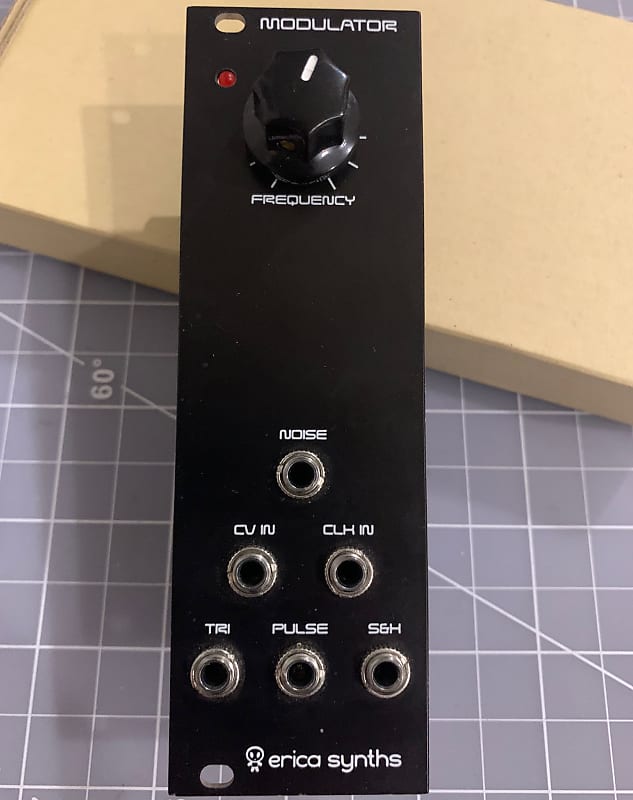Envelope generator and VCA combo in 3HP
http://www.ericasynths.lv/en/shop/eurorack-modules/by-series/pico-series/pico-mod/
If you had an Unicorn Account you could see a chart with the price development of this module and the average price asked for this module.
The Erica Synths Modulator cleverly combines 3 different (though related) functions into a single 8HP module: it's a (white) noise source, LFO, and Sample-&-Hold all in one! The LFO and S&H sections are patterned after the Soviet-made Formanta Polivoks synth, with the LFO being a relaxation oscillator type and the S&H using the metal can Soviet К1100СК2Б. The S&H jacks are normalled so that (when not otherwise patched) white noise is fed to the input (labelled CV IN) and the LFO squarewave to the clock (labelled CLK IN), which generates stepped random voltages at the rate of the LFO.On the back of the module, there is a separate board containing the noise circuitry - Erica made both a simplified/basic transistor noise circuit and a more elaborate/complex zener diode noise circuit that could be slotted in here - this module has the latter. The pin connections are not glued, so the board may be swapped out at a later date if desired. While it uses a very large number of components for a noise source, the result has a pleasing "sizzling" quality that many appreciate. One of our customers absolutely swears by this noise circuit and says it's the best she's ever heard! The module has been thoroughly tested and everything's working as it should! Several modifications have been made to this module to ensure greater compatibility with other Eurorack modules - more on that below.Modifications:This module was originally assembled by one of our customers several years ago. They did an excellent job and the circuit/components matched the schematic perfectly. In spite of this, after a few months, the module wasn't quite doing what they wanted it to do. They were using an Arturia Microbrute as a control surface, and the gate output on the Arturia would not trigger the S&H clock on the Modulator due to the voltage being a bit low (~+3.9V if I remember correctly)...they had similar problems when using an early NiftyCase clock output. On the output side, when connecting the pulse output to certain other modules, the amplitude seemed to drop, and the frequency range of the LFO was very limited.We took the module and came up with a number of modifications to address key areas of concern without having to cut traces or add new connections. This is what we came up with:Frequency Range: Changed values of R1/R6/C1. This more than doubles the frequency range, allowing for lower frequencies and providing a vastly smoother control curve. In stock form, the range is about ~0.55Hz (1 cycle every 2 seconds) to 27Hz; while keeping the maximum freq the same, minimum now gets to ~0.1 Hz (1 cycle every 10 seconds) or slowerS&H Clock Input: Changed value of R21. This solves the problem with slightly-low voltages not triggering the S&H properly. It does increase control pulse length, but not by enough to be highly noticeable.Square Wave Output: Changed R8/R9/R11/R17 to correct output impedance. The original design gives an output impedance of ~5K4Ω, which is far greater than the 1KΩ Eurorack standard. This can result in substantial amplitude drops - for example, if patching to a module that uses a B10K attenuation potentiometer, maximum amplitude drops by over ⅓!This module owned by the same customer for ~4 years after those modifications were made, and the module still works perfectly; I've just tested all of the functions to be sure of that! They wound up trading the module toward a similar custom build - one similar to the Modulator, but with a dedicated oscillator for the S&H (able to go up to very high frequencies, over 14KHz, for sample rate reduction patches), CV frequency inputs for both oscillators, and an added pink noise output.Thanks for reading - I know that's a lot of information (and a lot of history on this module specifically) - feel free to shoot me a message with any questions!

This offer was fetched from reverb.com. You cannot contact the seller via ModularGrid. You have to visit their site.
Look up onDisclaimer: Modules listed for sale on the ModularGrid Marketplace are offered explicitly by their respective owners. ModularGrid is not affiliated to the sellers and takes no legal responsibility in any transaction.
The internet is a rough place and fraudulent behavior can occur. If you are concerned about dealing with strangers consider buying your module at an authorized dealer.